(209) A dog in Nara period
文字数 3,011文字
Tsukuba has three nationally designated cultural properties: Oda Castle Ruins, Hirasawa Kanga Ruins, and Konda Kanga Ruins.
This time, I would like to introduce the Hirasawa Kanga Ruins.
“Kanga” means a government office, and Kanga ruins refer to the remains of ”Kokuga” (国衙, ancient government offices) and “Gunga”(郡衙, ancient county government offices).
In 713, the emperor ordered the compilation of Fudoki (which means topography) in order to know the situation of each region of Japan (currently called prefecture) and use it as a guideline for local administration. Of the 50+ Fudoki that were written at that time, only five remain today: Izumo Fudoki, Harima Fudoki, Hizen Fudoki, Hitachi Fudoki, and Bungo Fudoki.
The Hirasawa Kanga Ruins is believed to be the site of the Tsukuba District government office, one of the 11 regions that appear in the Hitachi Fudoki. Approximately 50 raised-floor warehouses from the Nara and Heian periods have been confirmed through excavation.
In 1997, restoration work began on three buildings: Azekura, Tsuchikura, and Itakura. And since 2003, the area has been open to the public as a historical park called “Hirasawa Kanga Ruins Historical Hiroba”.
In this park, many events are held including "Shiba-yaki (Grass Burning)" in early spring, "Manto (lanterns) Summer Festival" in summer, and a concert called "Tsukuba Monogatari."
Twenty years have passed since the opening of the historical park, and the three restored buildings have become dilapidated.
Dogs came to Japan about 10,000 years ago. From the mansion of Prince Nagaya, which existed in the Nara period, wooden tablets with dogs’ names were excavated. Dogs have always been friends with humans.
Cats have also helped humans.
During the Nara period, various scriptures were imported from China. Rats devoured the paper, so, to protect the scriptures, cats were brought from China to catch mice and were kept at temples and shrines. I’m wondering if the cat in Sosuke Natsukawa's "The Story of a Cat Trying to Protect a Book" knows this.
It seems that common people began to keep cats after the Muromachi period.
Cats came to Japan much earlier than Chihuahuas, but they are newcomers compared to other dogs.
I felt like I was a dog in the Nara period, and I took a walk in the historical park, focusing on the three restored buildings.
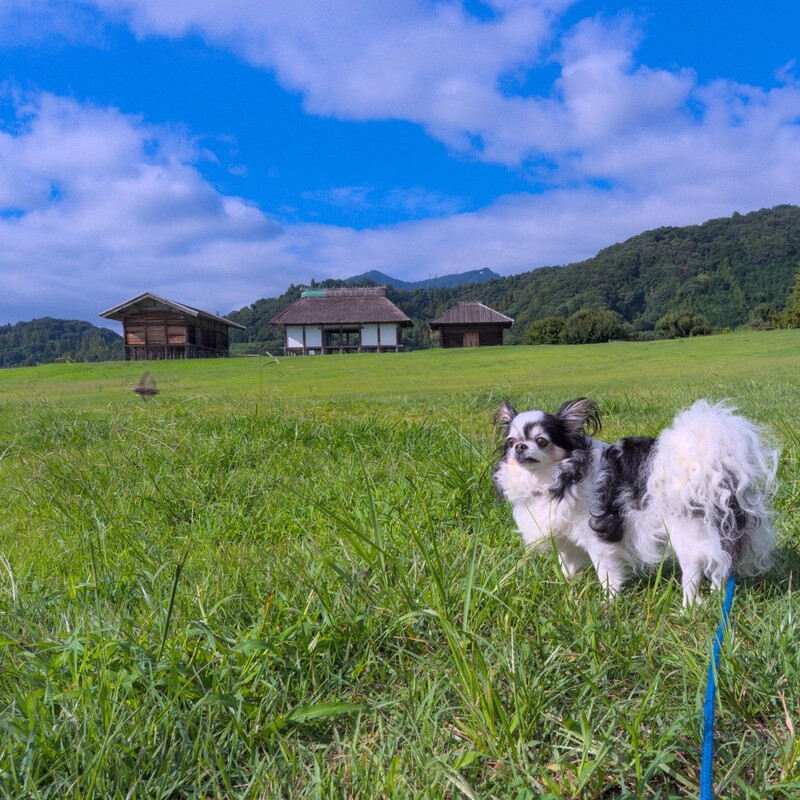
①This is the entrance of the historical park where you can see three buildings and Mt.Tsukuba.

② I’m happily running around the wide lawn.
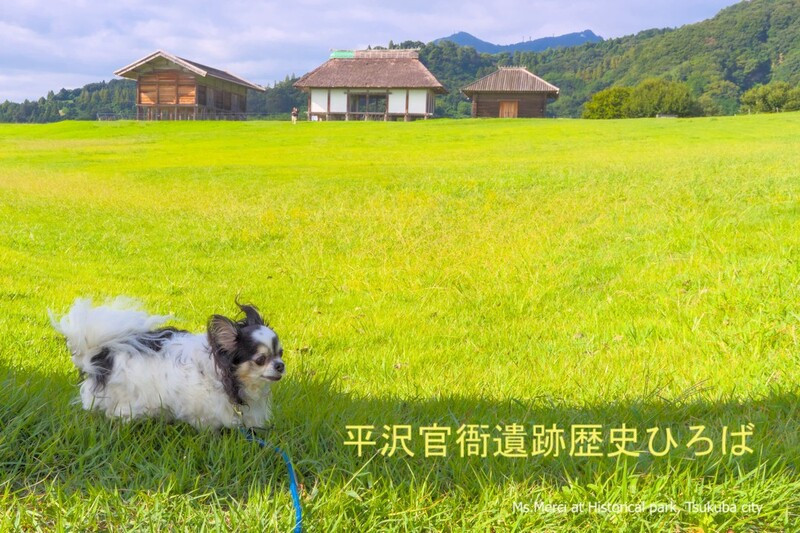
③ Dad processed the above photo into a poster. It says “ Hirasawa Government Office Historical Ruins Square.” I wonder if I can become a goodwill ambassador to guide you through historic sites.
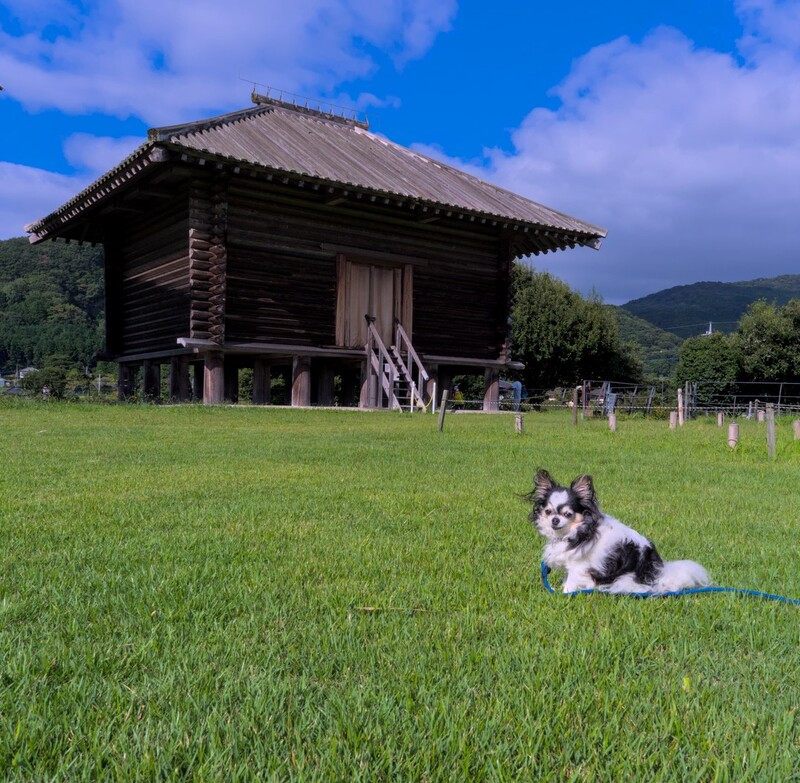
④ I'm in front of Building No.1.
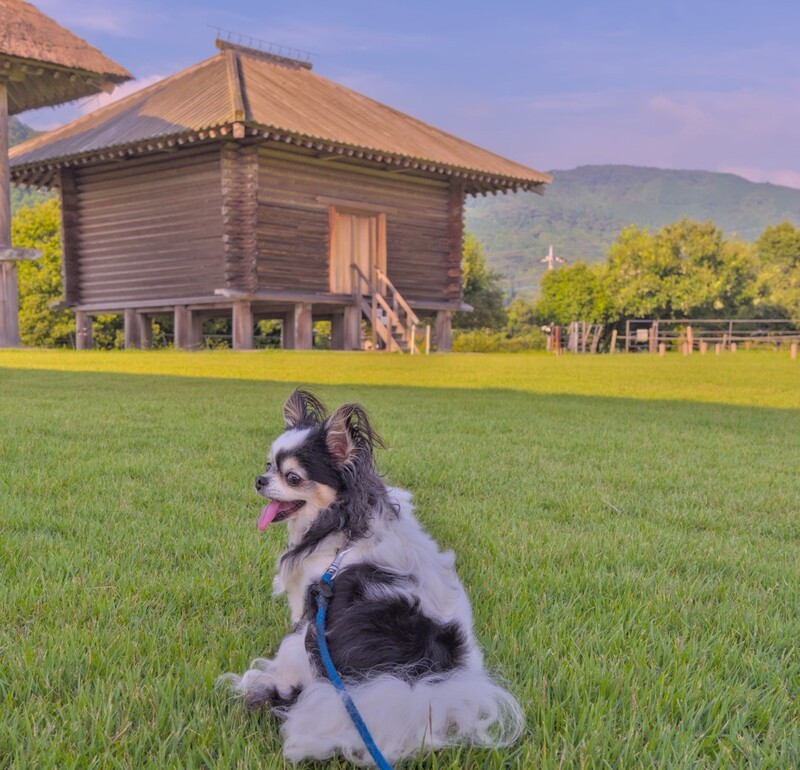
⑤ I’m in front of Building No1. It looks very different in the light.
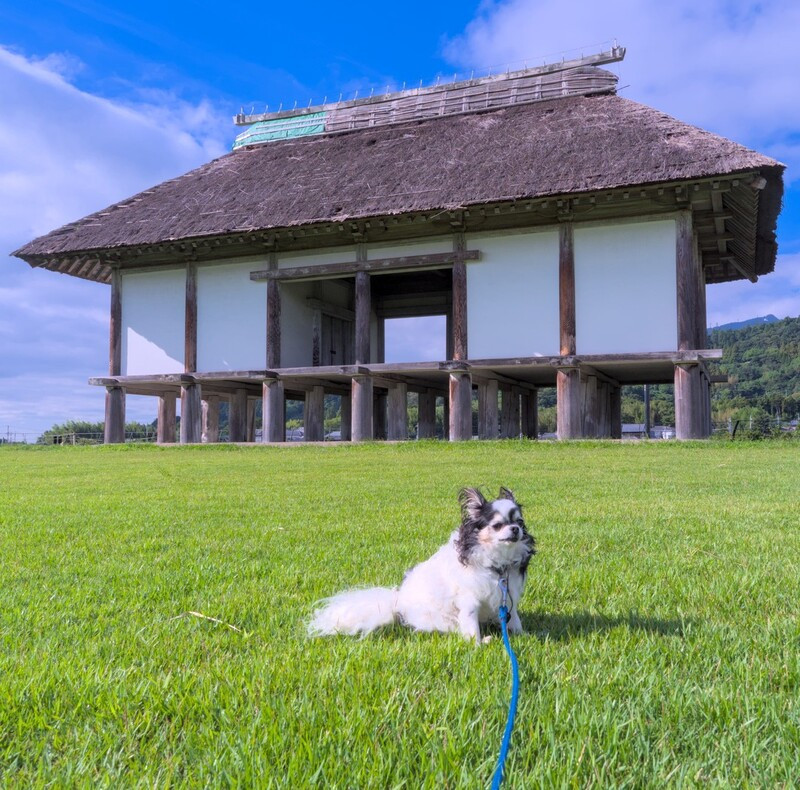
⑥ I’m in front of Building No.2. It has a mysterious hole.

⑦I’m next to Building No.2.
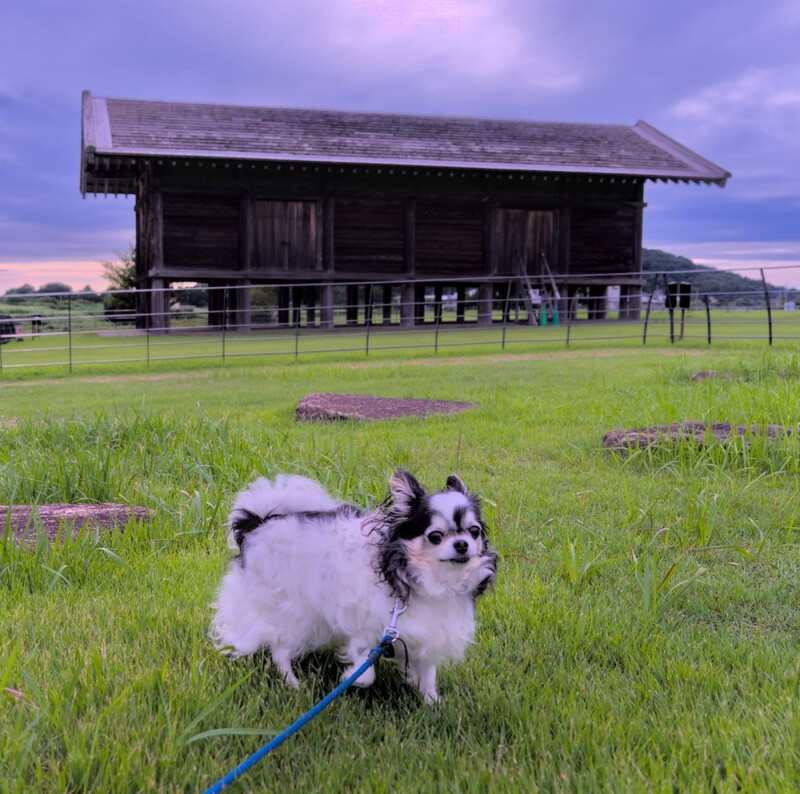
⑧ I’m in front of Building No.3.
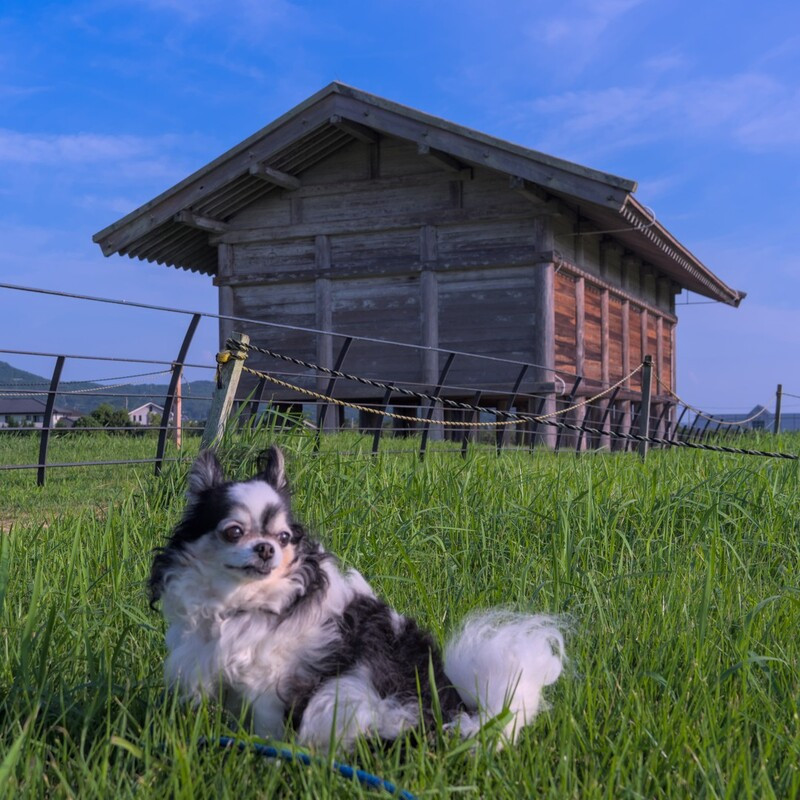
⑨ I’m next to Building No. 3.
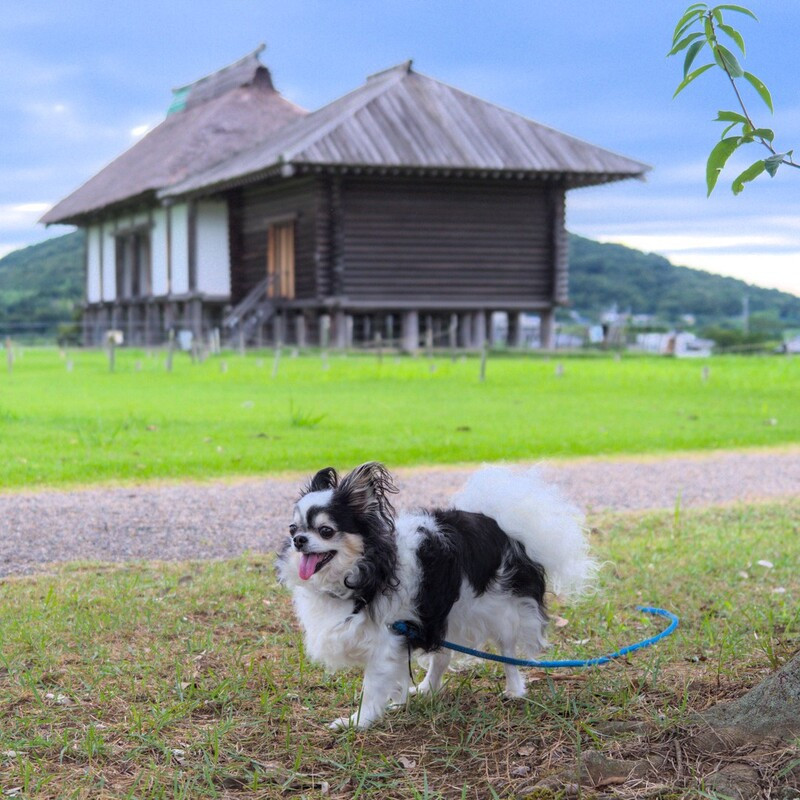
⑩ I’m next to Building No. 1 and Building No. 2.
This time, I would like to introduce the Hirasawa Kanga Ruins.
“Kanga” means a government office, and Kanga ruins refer to the remains of ”Kokuga” (国衙, ancient government offices) and “Gunga”(郡衙, ancient county government offices).
In 713, the emperor ordered the compilation of Fudoki (which means topography) in order to know the situation of each region of Japan (currently called prefecture) and use it as a guideline for local administration. Of the 50+ Fudoki that were written at that time, only five remain today: Izumo Fudoki, Harima Fudoki, Hizen Fudoki, Hitachi Fudoki, and Bungo Fudoki.
The Hirasawa Kanga Ruins is believed to be the site of the Tsukuba District government office, one of the 11 regions that appear in the Hitachi Fudoki. Approximately 50 raised-floor warehouses from the Nara and Heian periods have been confirmed through excavation.
In 1997, restoration work began on three buildings: Azekura, Tsuchikura, and Itakura. And since 2003, the area has been open to the public as a historical park called “Hirasawa Kanga Ruins Historical Hiroba”.
In this park, many events are held including "Shiba-yaki (Grass Burning)" in early spring, "Manto (lanterns) Summer Festival" in summer, and a concert called "Tsukuba Monogatari."
Twenty years have passed since the opening of the historical park, and the three restored buildings have become dilapidated.
Dogs came to Japan about 10,000 years ago. From the mansion of Prince Nagaya, which existed in the Nara period, wooden tablets with dogs’ names were excavated. Dogs have always been friends with humans.
Cats have also helped humans.
During the Nara period, various scriptures were imported from China. Rats devoured the paper, so, to protect the scriptures, cats were brought from China to catch mice and were kept at temples and shrines. I’m wondering if the cat in Sosuke Natsukawa's "The Story of a Cat Trying to Protect a Book" knows this.
It seems that common people began to keep cats after the Muromachi period.
Cats came to Japan much earlier than Chihuahuas, but they are newcomers compared to other dogs.
I felt like I was a dog in the Nara period, and I took a walk in the historical park, focusing on the three restored buildings.

①This is the entrance of the historical park where you can see three buildings and Mt.Tsukuba.

② I’m happily running around the wide lawn.

③ Dad processed the above photo into a poster. It says “ Hirasawa Government Office Historical Ruins Square.” I wonder if I can become a goodwill ambassador to guide you through historic sites.

④ I'm in front of Building No.1.

⑤ I’m in front of Building No1. It looks very different in the light.

⑥ I’m in front of Building No.2. It has a mysterious hole.

⑦I’m next to Building No.2.

⑧ I’m in front of Building No.3.

⑨ I’m next to Building No. 3.

⑩ I’m next to Building No. 1 and Building No. 2.
